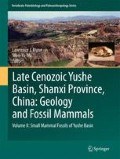Abstract
The screen-washing activities of three field seasons by the Sino-American Yushe teams processed tons of sediment from two dozen localities. Of the many micromammals recovered from Late Neogene deposits, only five chiropteran (bat) teeth were found. These are from five localities dated between 6 and 3 Ma. The bat fossils are assignable or very close to modern genera. In distribution, three of the genera occur in North China today, while at least one is currently of more southerly distribution, occurring to the southwest in Sichuan Province. Together with Pleistocene records, the Yushe Basin fossils suggest that current bat distributions are reduced with respect to early Pleistocene species ranges.
Access this chapter
Tax calculation will be finalised at checkout
Purchases are for personal use only
References
Engesser, B. (1980). Insectivora und Chiroptera (Mammalia) aus dem Neogen der Türkei. Schweizerische Paläontologische Abhandlungen, 102, 47–149.
Horáček, I. (1986). Kerivoula (Mammalia, Chiroptera), fossil in Europe? Acta Universitatis Carolinae – Geologica, Špinar 2, 213–222.
Hu, Q.-Q., Jin, C.-Z., Li, Y., & Hou, L.-H. (1992). Dalian Haimao Fauna. Dalian: Scientific and Technological University of Dalian Press.
Jin, C.-Z., Kowamura, Y., & Taruno, H. (1999). Pliocene and Early Pleistocene insectivore and rodent faunas from Dajushan, Qipanshan, and Haimao in North China and the reconstruction of the faunal succession from the Late Miocene to Middle Pleistocene. Journal of Geosciences, Osaka University, 42, 1–19.
Jin, C.-Z., & Liu, J.-Y. (2008). Paleolithic Site – The Renzidong Cave, Fanchang, Anhui Province. Beijing: Science Press.
Kowalski, K., & Li, C.-K. (1963). Remarks on the fauna of bats (Chiroptera) from Locality 1 at Choukoutien. Vertebrata PalAsiatica, 7, 144–150.
Pei, W. C. (1936). On the mammalian remains from Locality 3 at Choukoutien. Palaeontologica Sinica, C7(5), 1–107, 6 plates.
Qiu, Z.-D., Han, D.-F., Qi, G.-Q., & Liu, Y.-F. (1985). A preliminary report on a micromammalian assemblage from the hominoid locality of Lufeng, Yunnan. Acta Anthropologica Sinica, 4, 13–32.
Qiu, Z.-D., Li, C.-K., & Hu, S.-J. (1984). Late Pleistocene micromammal fauna of Sanjiacun, Kunming. Vertebrata PalAsiatica, 22, 281–293.
Qiu, Z.-D., & Storch, G. (2000). The early Pliocene micromammalian fauna of Bilike, Inner Mongolia, China (Mammalia: Lipotyphla, Chiroptera, Rodentia, Lagomorpha). Senckenbergiana Lethaea, 80, 173–229.
Schlosser, M. (1924). Tertiary vertebrates of Mongolia. Palaeontologica Sinica, C1(1), 1–133.
Wang, Y.-X. (2003). A complete checklist of mammal species and subspecies in China: A taxonomic and geographic reference. Beijing: China Forestry Publishing House.
Young, C. C. (1934). On the Insectivora, Chiroptera, Rodentia and Primates other than Sinanthropus from Locality 1 at Choukoutien. Palaeontologica Sinica, C8(3), 1–160.
Zdansky, O. (1928). Die Säugetiere der Quartärfauna von Chou-k’ou-tien. Palaeontologica Sinica, C5(4), 1–146, 16 plates.
Acknowledgements
I thank Will Downs and Wen-Yu Wu for their careful labors during the screening , and Tai-Ming Wang for field work in the Nihe subbasin, which produced the Nihe bat tooth. The collections of the Museum of Comparative Zoology at Harvard University under the care of Judith Chupasko and Mark Omura were invaluable for identifications. Reviewers Nick Czaplewski, Bill Korth, Mark Omura, and Wen-Yu Wu offered many improvements.
Author information
Authors and Affiliations
Corresponding author
Editor information
Editors and Affiliations
Rights and permissions
Copyright information
© 2017 Springer Science+Business Media B.V.
About this chapter
Cite this chapter
Flynn, L.J. (2017). The Bats of Yushe. In: J. Flynn, L., Wu, WY. (eds) Late Cenozoic Yushe Basin, Shanxi Province, China: Geology and Fossil Mammals. Vertebrate Paleobiology and Paleoanthropology. Springer, Dordrecht. https://doi.org/10.1007/978-94-024-1050-1_3
Download citation
DOI: https://doi.org/10.1007/978-94-024-1050-1_3
Published:
Publisher Name: Springer, Dordrecht
Print ISBN: 978-94-024-1049-5
Online ISBN: 978-94-024-1050-1
eBook Packages: Earth and Environmental ScienceEarth and Environmental Science (R0)

